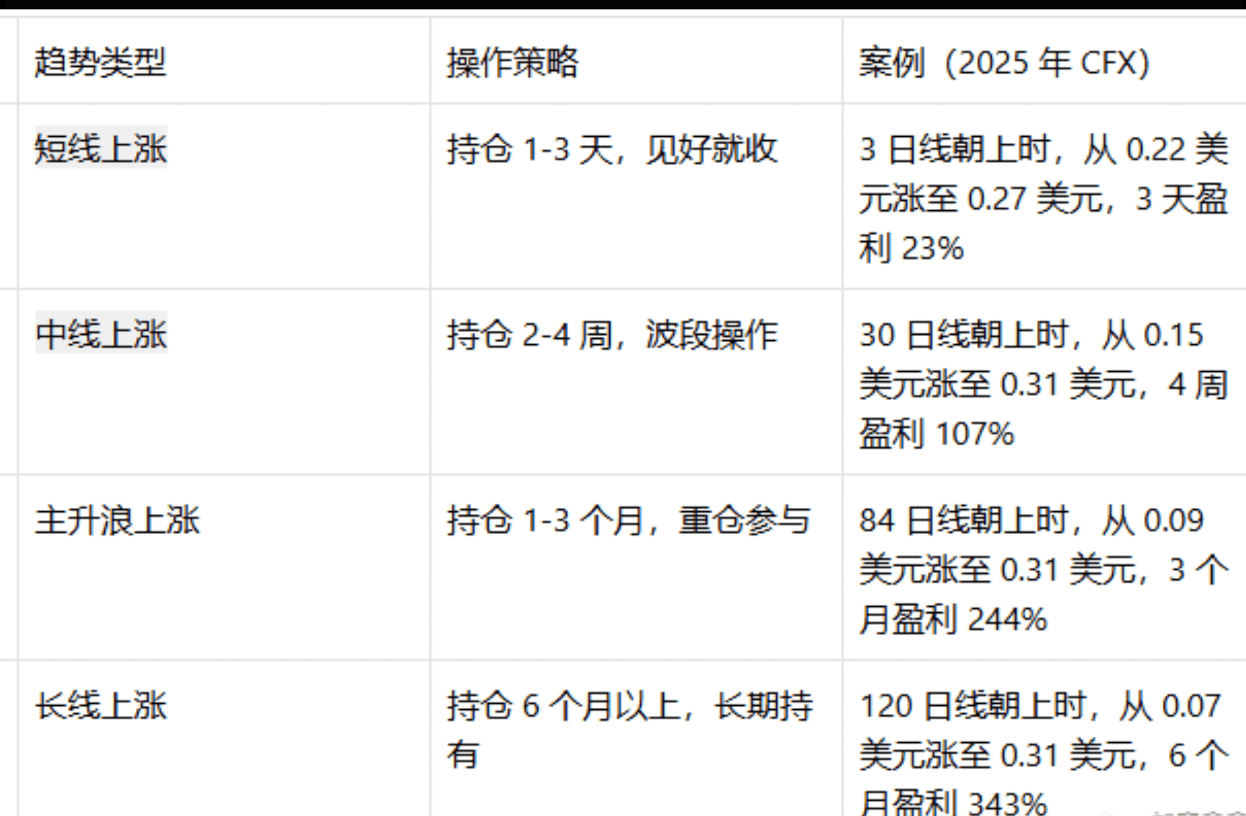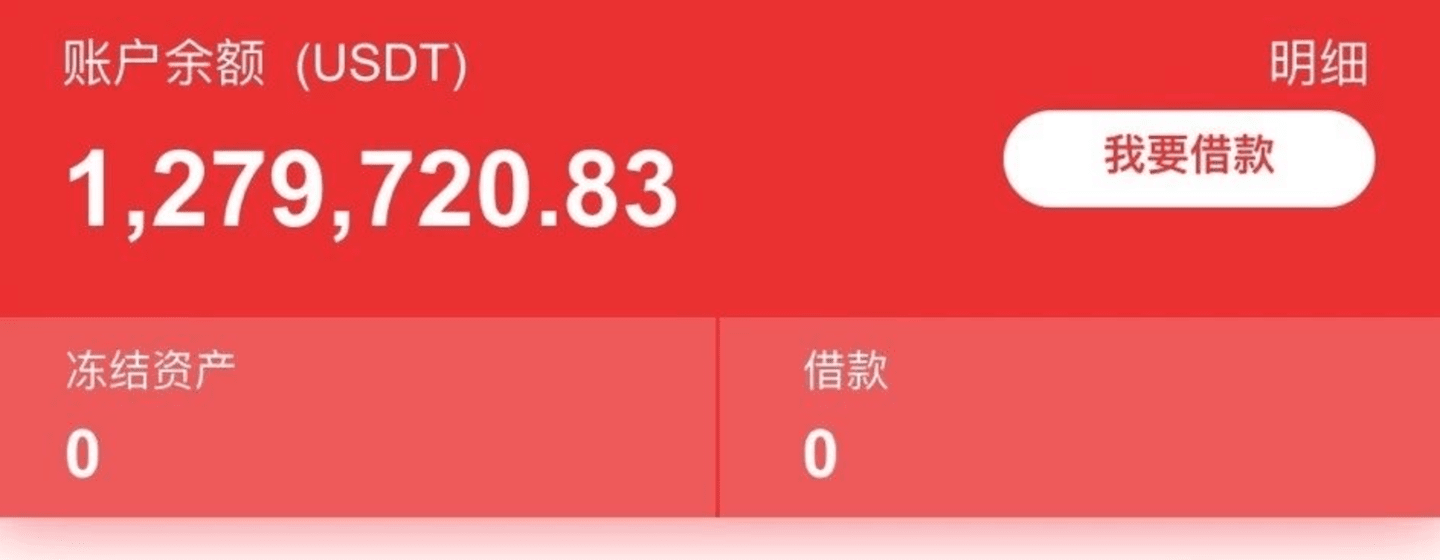Ten years of sharpening a sword — the 'simple method' logic from retail investor to eight-figure funds.
I entered the crypto space at 22 years old, experienced over 10 years of bull and bear market tests, and after accumulating practical experience in stocks, futures, and various fields, ultimately found the core logic of 'almost 100% profit' in the cryptocurrency market — reject trading based on feelings, replace speculation with discipline, and use replicable strategies instead of random decisions. In 2024-2025, it was through this 'simple method' that my capital scale broke into eight figures.
The following 4 rules are the essence of practical experience I summarized from countless losses, each corresponding to real-life lessons and gains.
4 core trading rules: full process coverage from improving win rates to risk control.
(1) Rule 1: The core of improving win rates — only trade 'with the trend', reject 'counter-trend speculation'.
Core logic: 90% of losses in the crypto space stem from 'counter-trend bottom fishing', while the key to profitability lies in 'trend-following low buying'. In a downward trend, all rebounds are traps (for example, in the 2024 bear market, BTC rebounded from $45,000 to $52,000, appearing strong, but subsequently fell to $38,000); in an upward trend, all pullbacks are 'golden opportunities' (in 2025, CFX pulled back from $0.27 to $0.18, representing a low buying opportunity before the main upward wave).
Practical comparison: Bottom fishing requires precise judgment of the 'bottom'; even a 10% error can result in being trapped by more than 30%; whereas low buying is waiting for a pullback in an upward trend, for example, entering near the 10-day moving average when the 3-day line turns upward, with at least a 60% improvement in win rate.
Key question: Would you rather gamble on the 'bottom' in a downward trend, or earn 'certain profits' in an upward trend? The answer is obvious.
(2) Rule 2: Avoid traps — do not touch coins with 'short-term rapid surges'.
Underlying logic: Whether mainstream coins (like ETH, SOL) or altcoins (like small-cap public chain tokens), less than 5% can achieve more than 2 waves of main upward trends. A short-term surge (for example, a rise of over 100% within 3 days) indicates that funds have already profited significantly and exited, resulting in very weak momentum for further increases — during high-level stagnation, buying cannot keep up, which naturally leads to a cascading decline.
Practical case: In May 2025, a certain Hong Kong concept altcoin X (anonymous) surged 80% in a single day due to 'false cooperation news', but the next day its trading volume dropped 50%, and then fell 65% over the next 3 days, trapping countless latecomer retail investors; in contrast, during the same period, CFX, though a leader in the Hong Kong concept, consistently maintained 'steady rise + low buying on pullbacks', rising from $0.12 to $0.31 within 3 months, without sharp surges or drops, providing investors ample exit opportunities.
Discipline requirement: If any coin's daily increase exceeds 30% or the 3-day increase exceeds 50%, directly add it to the 'blacklist'; even if it continues to rise afterward, never participate — opportunities in the crypto space are always present; missing one will not incur losses, but hitting one could lead to zero.
(3) Rule 3: Entry and exit point judgment — use MACD as a 'stable signal filter'.

Selection principle: Only choose coins with the '30-day line trending upwards'; even for coins below the 30-day line that have favorable policies, never participate — if the trend is wrong, efforts are in vain; rather than waiting for a rebound in a downward trend, it's better to profit easily in an upward trend.
(4) Rule 4: Weekly reviews — use discipline to ensure strategies do not deviate.
The core purpose of review: To check whether 'position logic' aligns with 'actual market trends', timely adjust erroneous decisions, and avoid small issues evolving into large losses.
Review process (must do every Sunday night):
Logic review: Reflect on the buying logic of held coins (such as policy-driven, upward trends) and determine whether the logic still holds (such as whether the policy has been implemented, whether the trend has changed).
Technical review: Observe weekly K-line trends — if the weekly K-line is still above the 30-week line and MACD is above the 0 axis, continue holding; if the weekly K-line falls below the 30-week line or MACD forms a dead cross, immediately reduce positions or stop loss.
Strategy adjustment: Adjust next week's plan based on review results — for example, if a certain coin profits 50% and experiences high-volume stagnation at a high level, plan to reduce positions by 50% next week; if a certain coin is still in a main upward wave, plan to increase positions during pullbacks next week.
Practical value: In June 2025, a coin I held fell below the 30-week line due to 'policy expectation delays'; through timely stop loss from the review, I avoided a subsequent 25% drop; had I not reviewed, I might have continued holding, leading to significant losses.
Summary: The only path to profit is from 'feelings' to 'discipline'.
The crypto space is not a casino, but rather 'a battlefield of strategy and discipline' — I was able to grow from a retail investor to having eight-figure funds, relying not on 'luck', but on the strict execution of these 4 rules. Remember:
Never trade based on feelings. Every buy, sell, increase, or stop loss must have clear indicator signals to support it.
Opportunities in the crypto space are always present; missing out is not scary, but being trapped due to greed or luck is.
Persist in using the 'simple method' — follow the trend, do not chase highs, do not average down, repeat the process; it may seem slow, but in reality, it is the fastest path to profit.
After experiencing multiple bull and bear markets, I deeply understand that the 'wealth code' has never been a 'get-rich-quick scheme' but rather 'the discipline of stable profit'. In the future, I will continue to share more practical experiences to help more people avoid loss traps and seize truly valuable opportunities — do not let 'feelings' ruin your capital; embrace profit with discipline, which is the only choice for long-term survival in the crypto space.

Many people feel that with little capital, there are no opportunities, but the opposite is true; small funds, if the right path is found, can roll out a snowball faster. Today, I will share this set of operations that have been verified in practice with you; just follow it, and you will avoid detours:
① Split capital to manage risk effectively.
A student started with 800U; I instructed him to only use one-third for the first trade and strictly leave the remaining funds in the account untouched. Many people cannot resist adding positions, bottom fishing, or even holding firm during market declines, resulting in deeper losses. From the beginning, we adhered to discipline: no adding positions, no bottom fishing, no holding firm, ensuring every step has controllable risk; even if the first trade didn't meet expectations, it wouldn't cause severe damage.
② Only capture high-certainty opportunities, do not chase turbulent operations.
I will help him accurately judge the timing, only taking action when certainty is high, never blindly chasing uncertain fluctuations. Even when encountering a significant market trend, I won't be greedy thinking 'I want to fill my plate', but rather divide it into three parts and proceed slowly, ensuring each part can steadily earn profits, accumulating small amounts into larger ones is more solid.
③ Profit roll-over, let profits help you make money.
After his first trade made 100U, I instructed him to use the profits from that 100U for the second trade, keeping the principal unchanged. This way, the position will gradually expand with profits, and operating with profits will be psychologically steadier, eliminating the panic of losing principal.
④ Take profits when they arise, do not cling to battles or be greedy.
Many people clearly make money but always think 'just wait a bit longer, it will rise more', resulting in market reversals, losing all profits and potentially going into the negative. Our principle is: no matter how good the market is, do not cling to battles; earn what you should earn in each phase of the market and secure profits timely. Rolling over is never about gambling on luck, but about consistently taking profits steadily and relying on compounding to accumulate bit by bit, which allows for long-term growth.

The seven things you should never do when trading coins...
If you plan to invest in the crypto space, please take a few minutes to read my post word for word, as it may save your life and your family. Thousands of originally happy families have ended up in ruin, all stemming from the pursuit of an unattainable dream of striking it rich in the crypto world.
Seven major prohibitions in trading coins.
The first major taboo of trading coins — being overly engaged.
Being overly engaged refers to investors continuously operating throughout the 365 days of the year, 24 hours a day. Whether trading coins or stocks, the most important thing is to judge the overall trend. When the trend is good, actively go long; when the trend weakens, either stay out of the market or hold light positions and rest. Some investors do not do this; regardless of the market's heat or cold, they work tirelessly every day, like busy bees, for minor profits. This approach not only leads to wasted effort but can also expose them to more risks. Investors in the crypto market must learn to assess the situation, adapt to trend changes, and rest at the right times to accurately seize the opportunities they should participate in. Otherwise, this 365x24 rhythm will wear you down.
The second taboo of trading coins — rushing to recover losses.
In a market crash, investors are often severely trapped, suffering massive paper losses. Some investors, eager to recover losses, randomly increase their trading frequency or invest more funds to average down, blindly reducing their costs. This approach is not only futile but can also worsen the degree of loss. In a weak market, investors should trade less or not at all, patiently waiting for a warming trend before re-entering once the trend is clear.
The third taboo of trading coins — being overconfident.
Being overconfident refers to investors always wanting to buy at the lowest price and sell at the highest price, blindly pursuing maximum profit. Some investors enjoy chasing high returns, wanting to capture all profits from a coin, resulting in frequently going back and forth like an elevator. Strive for the most achievable profits, let go a bit at the front, let go a bit at the back, eat more in the middle, and grow steadily — that's the right way to make money.
The fourth taboo of trading coins — rushing to catch rebounds.
Especially in a declining market, trying to catch rebounds is like 'taking chestnuts from a fire'; any slight misstep can bring trouble upon oneself. In the recent market environment, there is no possibility of missing out; investors must not risk being deeply trapped for the sake of chasing minor rebound profits.
The fifth taboo of trading coins — being fully invested and using leverage.
In the crypto space, most are forced out due to excessive leverage, ultimately facing forced liquidation by exchanges. Trading stocks and living should be similar; one must leave room for maneuvering to succeed. For retail investors, if the money invested in crypto is all for supporting a family, once fully invested and trapped, the immense psychological pressure will affect the analysis and judgment of future market trends, leading to inevitable results.
The sixth taboo of trading coins — excessive panic.
Panic is the most common emotion among investors during market crashes. In the crypto space, there are rises and falls, slowness and speed; this is a very natural law. Nothing will continuously move in one direction, and no coin will fall forever; there will ultimately be a time for rising. Investors should take advantage of the bear market's sluggishness to study diligently, actively select coins, and prepare early for the upcoming bull market, to avoid falling into the old habit of chasing highs and cutting losses when the market turns better.
The seventh taboo of trading coins — complacency.
Some investors can still make profits when they first enter the crypto world, but after becoming seasoned investors, they become blindly confident due to some profits, learned indicators, and a few books read. They chase highs and sell lows, entering and exiting quickly, resulting in more losses than wins and severe losses. Pride and complacency hinder investors from improving their operational level and can lead to distorted perceptions of the overall market. Whether in crypto or the stock market, development is ever-changing. Anyone who is proud and complacent will stagnate and ultimately be eliminated.




